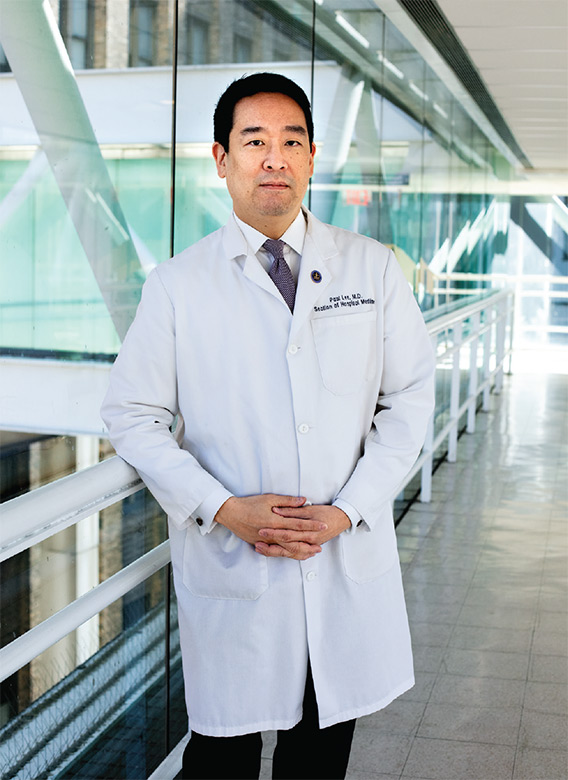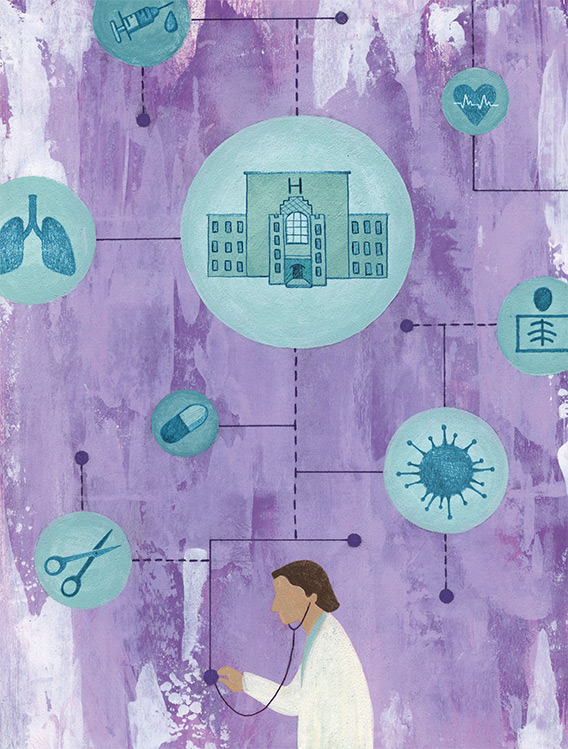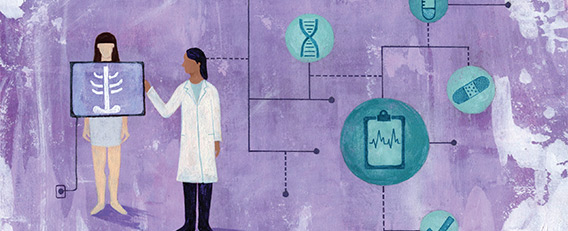The Life of a Hospitalist: Intense, Challenging, Gratifying
Jason Adelman, MD, MS, assistant professor of medicine at CUMC and patient safety officer and associate chief quality officer at NYP/CUIMC
Lisa Bednarz, LCSW, ACM, social worker at NYP/CUIMC
Wilson Bourjolly, MD, assistant professor of medicine at CUMC and associate medical director of the hospitalist program at Allen Hospital
Donald W. Landry, MD, PhD, the Hamilton Southworth Professor of Medicine; chair of the Department of Medicine at the Vagelos College of Physicians and Surgeons; and director of the medical service at NYP/CUIMC
Paul Lee, MD, MPH, the Harry C. and Misook Doolittle Professor of Medicine at CUMC, medical director of the Section of Hospital Medicine in the Division of General Medicine at NYP/CUIMC, and medical director for Global Services at NYP/CUIMC
Derek Mazique, MD, assistant professor of medicine at CUMC and patient safety officer and associate chief quality officer at Allen Hospital
Ashmi Patel, MD, assistant professor of medicine at CUMC and associate medical director of the Section of Hospital Medicine at NYP/CUIMC
Zorica Stojanovic, MD, assistant professor of medicine at CUMC and medical director of the hospitalist program at Allen Hospital
"I’m sorry," says Paul Lee, MD, as he picks up his cell phone. “I really have to take this.”
Dr. Lee, director of hospital medicine at NewYork-Presbyterian/Columbia, is sitting in a conference room on the eighth floor of the Milstein Hospital Building. The views of the Hudson River and the Manhattan skyline are stunning, but Dr. Lee has no time to admire the scenery. Instead, he is trying to help a physician find a specialist to consult on a patient.
Dr. Lee fields requests like this all the time and with good reason: With more than a dozen years of experience as a hospitalist—a physician who spends 100% of his or her time in the hospital—he is the go-to person for colleagues who need to arrange consultations and services.
“Many of the attending surgeons will call me and say, ‘I’ve got a patient, they’ve got this problem, can you help me find someone?’” he says.
That kind of care coordination is one of the most obvious benefits that hospitalists, who typically know their institutions far better than doctors who spend only a portion of their time on site, are able to provide. Yet brokering consults is only one of the many vital roles that Dr. Lee and his fellow hospitalists at Milstein and Allen Hospital in Upper Manhattan perform.
With the exceptions of a psychiatric hospitalist in Milstein and a small group of hospitalists in neurology and oncology, the majority of hospitalists at Milstein and Allen—like most hospitalists elsewhere—are internists who are called upon to treat a wide range of medical conditions. They admit patients from the emergency room and design their treatment plans; provide care for individuals who lack primary care physicians; and work with physicians assistants, social workers, and others to coordinate care within the hospital and prepare patients for discharge—all while providing consultations and training house staff and medical students. At Columbia, many are also active as course directors, clinical teachers, and medical student advisers at VP&S.
On the Front Lines of a Pandemic
The hospitalists at Milstein and Allen were ideally suited to treat the COVID-19 patients who began appearing in late winter—first in a trickle, then in a flood—as New York City became the global epicenter of the pandemic. As generalists, they were well-equipped to deal with a respiratory illness that can also cause neurological and cardiological symptoms. “There was virtually no system unaffected by this virus,” Dr. Lee says.
 Paul Lee
Paul LeeNonetheless, when the first COVID-19 patients began appearing at Milstein and Allen, little was known about the novel coronavirus. “All we knew was that this was a potentially deadly disease,” says Dr. Lee, adding that the hospitalists who treated the patients on the floors, like the doctors and nurses in the ERs and ICUs, were among the heroes of the early days of the pandemic, when uncertainty reigned and no one knew if simply showing up for work might prove deadly. “I think it took an enormous amount of courage, though I don’t think they saw it that way. They just felt that they were doing their jobs.”
They were not alone. As the number of cases peaked in mid-April, outpatient doctors poured in to help with the deluge of patients. “We couldn’t have survived without them,” says Zorica Stojanovic, MD, who directs the hospitalist program at Allen. Former residents returned from as far away as California to volunteer their services. Research fellows were granted temporary emergency privileges so they could help. And PAs from across the system were reassigned to COVID-19 duty. “For a little while, everyone became a hospitalist,” Dr. Lee says.
Even when the number of COVID-19 cases began to decline, life did not go back to normal. When many of the sickest patients who were gradually discharged from the ICUs required rehabilitation services, it was left to the hospitalists to care for them because nursing homes and long-term care facilities were not accepting admissions. At the same time, people in need of treatment for illnesses other than COVID-19 who had been avoiding the hospital for fear of being infected began to reappear, having neglected their conditions for a lengthy period.
Yet throughout, one thing remained constant: the hospitalist’s responsibility to care for whoever shows up at the hospital, no matter the reason.
“Everything was disrupted but the relationship to the patient,” says Dr. Stojanovic. “That was still present, and that was the essence of our job.”
Benefits of Hospitalists
Research has shown that hospitalist programs can shorten length of stay and reduce costs while preserving and even enhancing quality of care, patient outcomes, and patient satisfaction.
Speaking from an office overlooking Marble Hill in the south Bronx, Dr. Stojanovic points out that Allen physicians get a five-star rating on the Hospital Consumer Assessment of Healthcare Providers and Systems, a patient satisfaction survey required by the Centers for Medicare and Medicaid. The survey asks patients to rate how well doctors communicated with them during their stay and how well prepared patients were to leave.
The hospitalists’ impact on length of stay is impressive. Dr. Lee pulls up a series of charts and spreadsheets that illustrate the volume of discharges and the difference between expected length of stay and actual length of stay for patients in Milstein’s dedicated 36-bed hospitalist unit, known as 7 Garden South or 7GS, and various other units across the NewYork-Presbyterian Hospital network. (The unit on 7GS houses approximately one-third of the patients treated by Milstein’s hospitalists, with other patients occupying beds in other NYP locations.) The trend is clear: Almost from its inception, 7GS has discharged patients more efficiently than almost any other unit in the system. And it is always improving.
The efficiency means that patients can return home or enter a rehabilitation facility or nursing home more quickly, making space for new patients who require care. As Dr. Lee explains, the single greatest driver of hospital costs is the bed itself. Yet under the diagnosis-related group payment system employed by Medicare and some private insurers, the remuneration that hospitals receive is based on a patient’s diagnosis; whether the patient stays for three days or three weeks, the reimbursement is the same.
"It’s very tough to coordinate care if you are an outpatient doctor. As inpatient physicians, we can make things happen much faster."
The discharge and length-of-stay statistics for 7GS are especially striking when one considers that hospitalists tend to treat patients whose complex medical conditions and challenging psychosocial situations make it difficult to predict their course of stay. Unlike a hip replacement, it can be hard to know just how long it will take to treat and discharge an elderly patient with multiple organ failure and dementia who will ultimately need to be placed in a nursing home.
Nonetheless, patients admitted to 7GS are discharged on average half a day earlier than expected. “Based on my experience, that’s absolutely unheard of,” says Dr. Lee.
Drs. Lee and Stojanovic attribute much of their success to the teamwork among hospitalists, PAs, nurses, social workers, and care coordinators responsible for patient care and discharge of the complicated cases they see daily. But they also credit hospitalists’ ability to act as in-house quarterbacks who can supervise their own teams, order tests, arrange consultations, and otherwise coordinate care much more efficiently than primary care physicians who may only see their hospitalized patients once a day before or after office hours.
“It’s very tough to coordinate care if you are an outpatient doctor,” says Dr. Stojanovic. “As inpatient physicians, we can make things happen much faster.”
Hospitalists: A New Kind of Doctor
The roots of the hospitalist program at NYP/CUIMC can be traced to the very beginnings of the broader hospitalist movement, which emerged more than two decades ago in response to major shifts in the health care industry.
As the 20th century drew to a close, hospitals came under increasing pressure from managed care organizations to lower costs and increase efficiency even as they experienced a labor crunch. The labor crunch was largely the result of new limits on the number of hours that residents could work. The state of New York signed strict resident work-hour restrictions into law in 1989, and in 2003 the Accreditation Council for Graduate Medical Education imposed similar rules on all accredited medical training institutions in the United States. During the same period, declining reimbursements from insurers meant that PCPs who had traditionally volunteered a portion of their time treating hospital patients who did not have PCPs were less inclined to do so.
 Zorica Stojanovic
Zorica StojanovicThe time was ripe for a new approach to inpatient care—one that was pioneered by Lee Goldman, MD, Columbia’s dean emeritus of the Faculties of Health Sciences and Medicine. While serving as chair of medicine at the University of California San Francisco, Dr. Goldman and his colleague, Robert M. Wachter, MD, coined the term hospitalist to describe a new kind of specialist who would spend the bulk of his or her time in the hospital.
Hospital medicine, or hospitalism, quickly became one of the fastest growing specialties in health care; according to the Society for Hospital Medicine, the United States in 2019 had more than 60,000 hospitalists.
Yet the first hospital medicine programs, including those at Milstein and Allen, were quite humble. In 1996—the same year that Drs. Goldman and Wachter introduced the term hospitalist in an article in the New England Journal of Medicine—NYP/CUIMC hired its first two hospitalists. By 1999, when Dr. Stojanovic arrived, 12 physicians in the newly established Section of Hospital Medicine were covering both Milstein and Allen. And when Dr. Lee joined a few years later, the program had only recently added a nurse care manager and two social workers.
“Other doctors here didn’t know what the hospitalist program was all about,” Dr. Lee recalls. “When I said that I was a hospitalist, they assumed I meant hospice medicine.”
"Hospitalists not only have a direct impact on patient care and efficiency, they have evolved from an extension of our house staff to become a group of our strongest clinical faculty,"
No one would make that mistake today. In addition to Dr. Lee and Ashmi Patel, MD, associate medical director, the Milstein program has more than 25 hospitalists and almost 50 PAs. Allen has 20 hospitalists and 21 PAs.
Hospitalists can be found admitting patients in the ER; working in ICUs with intensivists during the day and without intensivists overnight; rounding in various wings and consulting with specialists; and presiding over 7GS, where they form part of a multidisciplinary team that includes nurses, social workers, and care coordinators.
Their presence also means that PCPs no longer have to rush to the hospital to supervise and coordinate care for their patients and can instead see more people during office hours. At Allen, community doctors join the hospitalists on grand rounds once a month but otherwise stay in touch by phone and email.
“Hospitalists not only have a direct impact on patient care and efficiency, they have evolved from an extension of our house staff to become a group of our strongest clinical faculty,” says Donald Landry, MD, PhD, chair of medicine at VP&S and director of the hospital’s medical service. “My faculty, and I too, look to have a hospitalist involved in the care of our friends and family whenever they are beset by serious illness requiring admission. I specifically selected Dr. Lee to be a key leader of the team caring for my younger son when he developed a devastatingly severe case of Guillain-Barré syndrome. The hospitalists are now an invaluable part of our faculty and the medical center.”
The hospitalists alternate months on teaching service, when they do rounds with residents and interns; during nonteaching months, they pair with PAs. Even during nonteaching months, notes Wilson Bourjolly, MD, a hospitalist at Allen and associate medical director of the hospitalist program at Allen, hospitalists continue to work with residents, interns, and medical students on rotation.
Like many of his colleagues, Dr. Bourjolly was drawn to the field in part by the variety, complexity, and severity of the cases that hospitalists see. “I can’t think of a day when I’ve been bored,” he says. “There’s always something challenging, something new.”

Hospitalist as Safety Net
Milstein and Allen care for large populations of at-risk, underserved patients, including immigrants, the elderly, the poor, and the homeless in northern Manhattan and the Bronx. Many are underinsured or uninsured and lack access to PCPs; by the time they arrive at the hospital, they often suffer from multiple ailments ranging from diabetes and hypertension to kidney disease and heart failure.
What’s more, says Lisa Bednarz, who oversees case management and social work for the Milstein program, many are grappling with psychiatric and psychosocial issues that further complicate treatment and discharge.
A homeless person suffering from chronic obstructive pulmonary disease and schizophrenia might show up in need of oxygen therapy, for example, then resist treatment because paranoia makes him or her distrustful of medical providers. An undocumented immigrant who is ineligible for services may need to remain in the hospital for months while staff try to sort out the patient’s legal status. And a developmentally disabled adult whose aging parents can no longer care for her may need a bed for up to a year while the hospital works with the
New York State Office for People with Developmental Disabilities for placement in group home housing.
“We are the safety net,” says Ms. Bednarz. “When people don’t know what else to do, they go to a hospital. And the hospitalists are the ones who take care of them.”
“Patients who come to the hospital are in a uniquely vulnerable place. Being a hospital medicine physician allows you to guide patients through this frightening, anxiety-provoking time in their life,” says Derek Mazique, MD, a hospitalist at Allen who also serves as Allen’s patient safety officer and associate chief quality officer. Because they are so deeply embedded in hospital operations, hospitalists often are also involved in patient safety and quality improvement initiatives. Last year, for example, hospitalist Jason Adelman, MD, who serves as patient safety officer and associate chief quality officer at NYP/CUIMC, became co-director of a new two-year patient safety research fellowship for hospitalists that is funded by the Agency for Healthcare Research and Quality.
If a hospitalist’s work is gratifying, it is also unremittingly intense. But unlike an outpatient doctor who may need to review cases after hours and answer calls from patients at night or on weekends, an off-duty hospitalist’s time is his or her own. When hospitalists are in the hospital, though, the work never stops. The intensity can be mitigated somewhat through careful scheduling. Hospitalists at Allen initially followed a traditional seven days on/seven days off schedule, but they now work Monday through Friday with rotating coverage on weekends to provide better work-life balance while also increasing continuity of care for patients. (Schedules were necessarily revised during the peak of the COVID-19 crisis: Milstein went to 12-hour shifts, Allen went from three daytime teams to nine, and coverage on nights and weekends had to be increased even as some hospitalists themselves fell ill.)
As Dr. Lee ticks off the seemingly endless list of responsibilities that hospitalists shoulder while on duty, he cannot help but wonder: Can a physician sustain a career in this specialty for 20 years?
The question, however, answers itself: As Dr. Lee points out, many at Milstein and Allen already have.
- Log in to post comments


